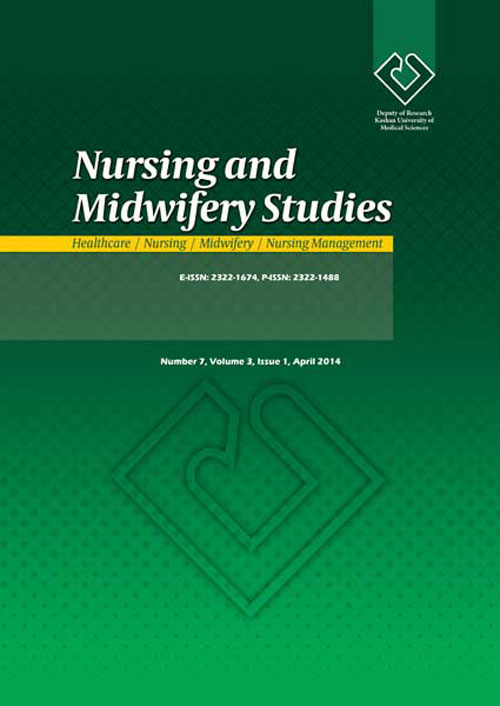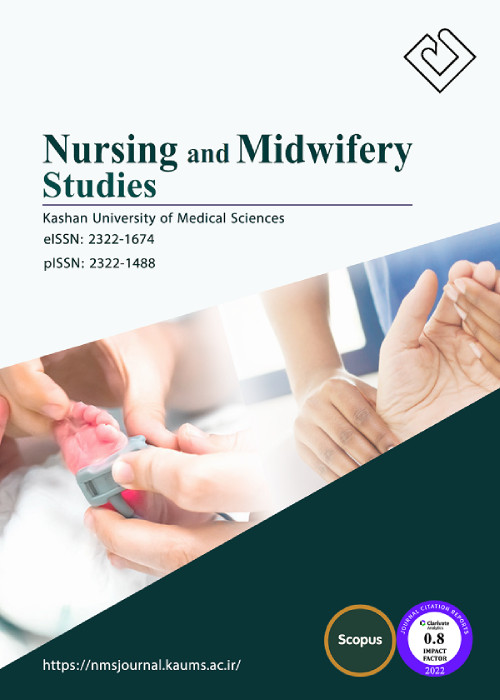فهرست مطالب

Nursing and Midwifery Studies
Volume:3 Issue: 3, Jul-Sep 2014
- تاریخ انتشار: 1393/08/27
- تعداد عناوین: 10
-
-
Page 1BackgroundMusic, as a non-pharmacological and inexpensive nursing intervention, can be used easily as a complementary technique in reducing pain along with other methods. While some studies have demonstrated pain to decrease after music, others found music to be ineffective on pain..ObjectivesThe aim of this study was to investigate the effect of music on postoperative pain in patients under open heart surgery..Patients andMethodsA quasi-experimental study was performed on 60 patients under open heart surgery referred to ICU of Shahid Beheshti hospital in Kashan city. Patients were randomly divided into two groups including experimental and control groups. Patients in music group listened to nonverbal music for 30 minutes after surgery by headphones. The control group did not receive any intervention other than routine care. Before and after intervention, pain intensity was measured and recorded by visual analog scale in two groups. Data was analyzed using Chi-Square and t-tests..ResultsBefore intervention, the mean of pain intensity was 6.32 ± 0.21 and 6.10 ± 0.21 for experimental and control groups, respectively; and the difference was not significant (P = 0.21). After intervention, the mean of pain intensity was 3.11 ± 0.12 and 5.81 ± 0.38 for experimental and control groups, respectively; and the difference was significant (P = 0.04)..ConclusionsListening to the relaxant music can reduce postoperative pain. It is suggested that relaxant music be used as a complementary method in patients in order to reduce prospective pain..Keywords: Music, Pain, Open Heart Surgery
-
Page 2BackgroundStomatitis is a disturbing side-effect of chemotherapy that disturbs patients and causes difficulties in patient’s drinking, eating and talking, and may results in infection and bleeding..ObjectivesThis study aimed to investigate the effect of Yarrow distillate in the treatment of chemotherapy-induced stomatitis..Patients andMethodsrapy-induced oral stomatitis referred to Shahid Beheshti Medical Center, Kashan, Iran. The data collection instrument had two-part; a demographic part and another part recording the severity of the stomatitis at the first, seventh, and 14th days of the intervention based on a WHO criteria checklist in 2005. In this study, 56 patients diagnosed with cancer were randomly assigned into control and experimental groups in similar blocks according to their stomatitis severity. The experimental group gargled 15 mL of a routine solution mixed with Yarrow distillate 4 times a day for 14 days while the control group gargled 15 mL of routine solution. The severity of stomatitis was assessed at the beginning of the intervention, and then after 7 and 14 days of the study. Data were analyzed using chi-square and Fisher exact test, Mann-Whitney U, Kruskal-Wallis, and Friedman tests using SPSS 11.5 software..ResultsAt first, the median score of stomatitis in the experimental group was 2.50 that significantly reduced to 1 and 0 in days 7 and 14 of the intervention, respectively (P value < 0.001). However, in the control group, the median score of stomatitis was 2.50, which significantly increased to 3 in days 7 and 14 (P value < 0.001)..ConclusionsYarrow distillate-contained solution reduced stomatitis severity more than the routine solution. Therefore, we suggest using it in patients with chemotherapy-induced stomatitis.Keywords: Yarrow distillatem, Chemotherapy, Stomatitis, Cancer, Mouthwashes
-
Page 3BackgroundPatient satisfaction is essential and must be taken into account when decisions are being made about changes and enhancements to services..ObjectivesThe aim of the current study was to assess patient satisfaction with the medical and nursing services provided to patients admitted to teaching hospitals affiliated to Arak University of Medical Sciences..Materials And MethodsThis was a cross-sectional study conducted in 2009. The study population consisted of all patients admitted to the study setting. The instrument consisted of a demographic questionnaire and patient satisfaction questionnaire. Study data were analyzed using Chi-square test, Pearson''s and Spearman''s rho correlation coefficient..ResultsIn terms of the medical and nursing care provided, 67% and 69% of the participants were satisfied, respectively. The ‘access to opportune nursing care’ and ‘physician’s manner’ items received 82.7% and 81.7% of scores, respectively. Satisfaction with medical and nursing care was significantly correlated with the participants’ education levels (P < 0.05)..ConclusionsThe study showed that patient satisfaction was at an average level, therefor, policy makers in the organizations should consider customer-based feedback and apply various methods to improve it..Keywords: Patient Satisfaction, Nursing care, Iran
-
Page 5BackgroundInadequacy of dialysis is one of the main causes of death in hemodialysis patients. Some studies have suggested that high‐flux membrane improves the removal of moderate-sized molecules while other studies indicate no significant effect on them..ObjectivesThis study aimed to investigate the dialysis efficacy of low-flux versus high-flux membranes in hemodialysis patients..Patients andMethodsForty hemodialysis patients participated in this cross-over clinical trial. Two sessions of low-flux and high-flux membrane dialysis were performed consecutively, in the first and second stage of the trial. In both stages, blood samples before and after the dialysis were taken and sent to the laboratory for assessment. Blood urea nitrogen (BUN), KT/V and the urea reduction ratio (URR) indexes were used to determine dialysis efficacy. Data were analyzed using t test and paired t test..ResultsThe mean KT/V was 1.27 ± 0.28 in high-flux and 1.10 ± 0.32 in low-flux membrane which, these differences were statistically significant (P = 0.017). The mean of URR was 0.65 ± 0.09 in high-flux and 0.61 ± 0.14 in low-flux membrane, which these differences were not statistically significant (P = 0.221)..ConclusionsThe high-flux membrane had better dialysis adequacy, so we suggest using high-flux membrane in hemodialysis centers..Keywords: Hemodialysis, Dialysis Efficacy, High, Flux Membrane, Low, Flux Membrane, Iran
-
Page 6BackgroundDelivery is one of the most stressful events in women’s life. Excessive anxiety, in turn, increases delivery and pregnancy complications. Mother’s positive experience of delivery leads to more effective maternal-fetal attachment in the first few hours of birth..ObjectivesThe present study aimed to compare the effects of acupressure at two different acupoints on anxiety level and maternal-fetal attachment in primiparous women..Materials And MethodsIn this study, 150 primiparous women were allocated to acupressure at GB-21 acupoint, acupressure at SP-6 acupoint, and control group. The women in their active phase of delivery were enrolled in the study and pressure was applied to the acupoints for 20 minutes. Mother’s anxiety level was assessed using Spielberger’s questionnaire before and one hour after the intervention. In addition, maternal-fetal attachment behaviors were evaluated using Avant’s questionnaire during the first breastfeeding. Then the data were introduced to the SPSS (v. 13) and were analyzed using t test and one way ANOVA..ResultsThe results revealed no significant difference among the three groups regarding the anxiety level before the intervention (P > 0.05). One hour after the intervention, this measure was significantly lower in the intervention groups in comparison to the control group (P < 0.001); However, no significant difference was found between the two intervention groups in this regard (P > 0.05). Moreover, maternal-fetal attachment was higher in the intervention groups in comparison with the control group (P < 0.001)..ConclusionsAcupressure at both acupoints reduced anxiety level and increased maternal-fetal attachment. This method can be easily used in the delivery room..Keywords: Acupressure, Anxiety, Maternal, Fetal Relations
-
Page 8BackgroundPrograms to improve the pain and health status in illnesses with pain such as headache are still in their infancy. Mindfulness-based stress reduction (MBSR) is a new psychotherapy that appears to be effective in treating chronic pain..ObjectivesThis study evaluated efficacy of MBSR in improving pain severity and mindful awareness in patients with tension headache..Patients andMethodsThis study was a randomized controlled clinical trial that was conducted in 2012 in Shahid Beheshti Hospital of Kashan City. Sixty patients who were diagnosed with tension-type headache according to the International Headache Classification Subcommittee were randomly assigned to treatment as usual (TAU) or MBSR groups. The MBSR group received eight weekly treatments. Any session lasted 120 minutes. The sessions were based on MBSR protocol. Diary scale for measuring headache and Mindful Attention Awareness Scale (MAAS) were administered at pretreatment, and posttreatment, and three-month follow-up in both groups. The data was analyzed using repeated measures analysis of variance..ResultsThe mean of pain severity was 7.36 ± 1.25 before intervention that was significantly reduced to 5.62 ± 1.74 and 6.07 ± 1.08 after the intervention and follow-up (P < 0.001). In addition, the MBSR group showed higher scores in mindful awareness in comparison with the control group at posttest session. The mean of mindful awareness before intervention was 34.9 ± 10.5 and changed to 53.8 ± 15.5 and 40.7 ± 10.9 after the intervention and follow-up sessions (P < 0.001)..ConclusionsMBSR could reduce pain and improve mindfulness skills in patients with tension headache. It appears that MBSR is an effective psychotherapy for treatment of patients with tension headache..Keywords: Mindfulness, Awareness, Pain, Tension, Type Headache
-
Page 10BackgroundDespite all progresses in surgical science, bleeding caused by traffic accidents is still a challenge for surgeons to save patients’ lives. Therefore, introducing an effective method to control external bleeding is an important research priority..ObjectivesThis study aimed to compare haemostatic effect of zinc chloride and simple suturing to control external bleeding..Materials And MethodsIn this animal model study, 60 male Wistar rats were used. An incision (two cm in length and half a cm in depth) was made on shaved back of rats. The hemostasis time was measured once using zinc chloride with different concentrations (5%, 10%, 15%, 25%, and 50%) and then using simple suturing. Skin tissue was assessed for pathological changes. Due to abnormal distribution of variables in Kolmogorov-Smirnov test, the data was analyzed using Kruskal-Wallis test Mann-Whitney U tests..ResultsIn all the groups, complete hemostasis occurred. Hemostasis times of different concentrations of zinc chloride were significantly less than that of the control group (P < 0.001)..ConclusionsZinc chloride was effective to control external bleeding in rats..Keywords: Hemostasis, Zinc Chloride, Rat


